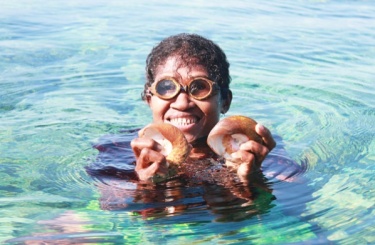
I heard this interesting news yesterday that West Papua is declared as the first province anywhere in the world; and the entire province is now a world conservation site. West Papua remains part of Indonesia. One is hopeful that the political status and the livelihood of West Papua people will be recognised as well.
If coral reefs are the rainforests of the seas, then the Coral Triangle is the underwater equivalent of the Amazon. This is a bioregion that’s half the size of the United States, passes through six countries (the Philippines, Indonesia, Malaysia, Papua New Guinea Solomon Islands and East Timor), and harbours more marine species than anywhere else on the planet. There are single reefs in the Coral Triangle that contain more species than the entire Caribbean. When it comes to abundance and sheer scale, nowhere else comes close to the Coral Triangle.

The First World Conservation Province – West Papua
The Indonesian province of West Papua has just been declared a Conservation Province, a first for both Indonesia and the rest of the world. The new designation is important both symbolically and in ensuring the future health of the province’s astonishing ecosystems. Besides its rainforests, West Papua is the world’s epicentre of marine biodiversity, boasting more species than anywhere else on the planet.

As forest fires rage in Sumatra in the midst of the worst El Nino weather event on record, this example of local government taking action in partnership with local communities and international NGOs shows that real, inclusive action is possible and that it can reach the legislative level.
The declaration was signed on Monday by West Papua governor Abraham Ataruri in Manokwari, the provincial capital, with Indonesia’s minister for Home Affairs, Tjahjo Kumolo in attendance. “This declaration will help us maintain and manage our natural resources wisely and continuously so that future generations can enjoy them,” said Ataruro. The new bylaw designating West Papua a Conservation Province falls under the jurisdiction of Indonesia’s Ministry for Forestry & the Environment.
Supported by Conservation International (CI), Worldwide Fund for Nature (WWF) and The Nature Conservancy (TNC), the local government in West Papua has set up a working group representing a range of civil and political bodies to ensure that the new legislation translates into meaningful action on the ground. They are now drawing up regional bills known as Ranperdasus.

Background Information
Papua (both Papua and West Papua provinces) is a complex piece of the planet, partly because of its convoluted tectonic history that forms mountainous areas, prominent lakes, swamps and mangroves where Indonesia’s largest mangrove ecosystem is nestled at the head of Bintuni Bay.
The north-western part of Papua is also part of the Coral Triangle Marine Protected Area, containing the world’s greatest diversity of coral-reef fish, with more than 1,650 species in eastern Indonesia alone. Papua’s abundant coastline is magnificent, placed together with more than 1,000 fringing islands like Raja Ampat, Biak, Supiori, Yapen and the satellite islands of Cenderawasih Bay, which also contribute significantly to Papua’s astonishing features.
It is currently considered an area of global priority for biodiversity conservation because, in part, of the species-rich forest environment of Australopapuan fauna, as well as of many uniquely New Guinean species.
Papua has huge reserves of natural resources in the mining and oil and gas sectors and continues to retain some 80 percent forest cover, including large reserves of commercially valuable lowland rainforest.
These all significantly contributed to the gross domestic product (GDP) of the provinces.
Despite its socially rich environment, Papua and West Papua are among the provinces with the highest level of poverty in the country. A report by the Central Statistics Agency (BPS) said that until March 2013, West Papua was among the eight provinces with the highest poverty rate (26.67 percent) — second after neighbouring Papua (31.13 percent). Jakarta Post
A note from the author of this blog – so finally the world is going to conserve the land, place and environment of the West Papua people is this the sign that times are changing for West Papua people? Could we apply the same kind of protection for the Melanesian PEOPLE in West Papua too?

Hopefully, things are really moving forward for West Papua. I’m quite awestruck by the importance of this vast region in terms of biodiverstity and all the natural resources you mentioned. Conservation must be a priority in such a rich area. It seems that poverty issues desperately need addressing, though. I’m going to read through all this again, Joycelin because there’s so much to take in.
LikeLike
Have a lovely weekend dear. 🙂
LikeLiked by 1 person
Hey Nomzi – you too. I hope you are doing something very nice. Thank you so much.
LikeLike
🙂
LikeLiked by 1 person